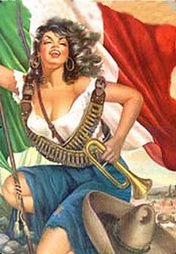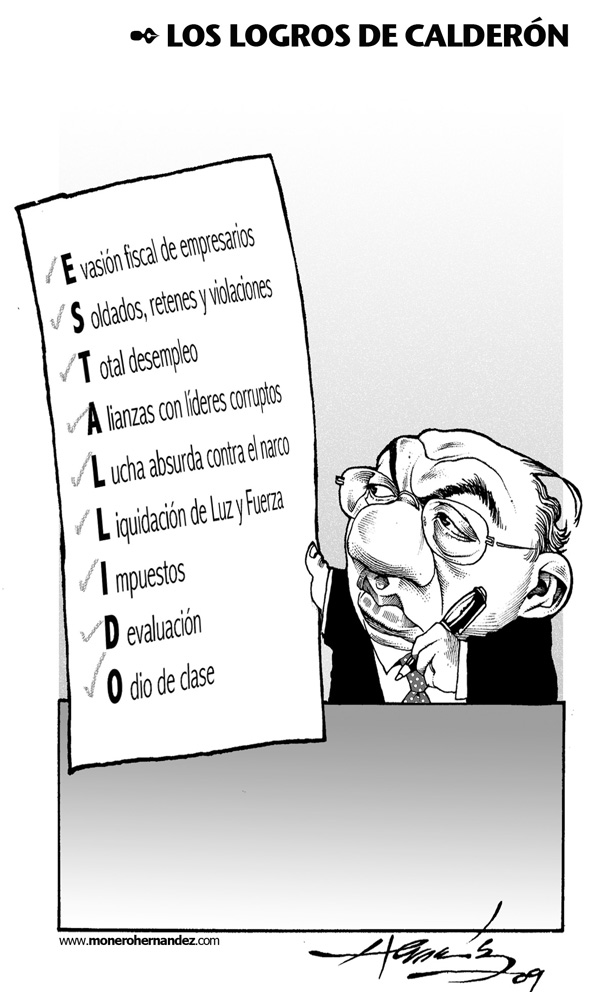
vendredi 13 novembre 2009
Nuevamente, referendo presidencial revocatorio
Gilberto López y Rivas
Los alegatos para llevar a cabo este procedimiento democrático después de dos años y medio de padecer su gobierno de facto, están más vigentes que entonces. Revisemos algunos y comprobemos que los peores vaticinios se cumplieron:
“Durante estas primeras 10 semanas de gobierno, el presidente espurio Felipe Calderón y el Partido Acción Nacional (PAN) delinearon los ejes programáticos que pretenden aplicar durante todo el sexenio: 1. militarización, contrainsurgencia, acciones represivas contra las fuerzas populares oposicionistas; cooptación de algunos sectores de la izquierda institucionalizada, absorción del priísmo y el sindicalismo oficialistas; 2. profundización del modelo neoliberal (con todo lo que eso significa para los niveles y las condiciones de vida de los mexicanos, sus derechos a la alimentación, educación, salud, seguridad, empleo, vivienda y bienestar social) y privatización de los recursos estratégicos; 3. sujeción absoluta de México a la hegemonía política, ideológica, cultural, militar, de inteligencia y seguridad de Estados Unidos; 5. control de los medios masivos de comunicación como instrumentos ideológicos al servicio de los poderes fácticos y del régimen calderonista que los representa...
Leer completa___________________________________________________________________
Publié par
Filotea y Meximiliano
à
13:18
0
commentaires
![]()
Libellés : desgobierno, politica
El Mexico de Calderon: la guerra mexicana
La Guerra Mexicana by Brian L. Frank
This photographic essay documents the violence due to the drug war in Mexico in 2008. The story, was completed over a period of 6 months, mostly in the notorious barrios of Tepito and Nezahualcoytl in Mexico City. However, in October, I also visited Juarez where, with the help of local journalists was able to document just a fraction of the rampant violence that has turned the border town into a war zone.
The work produced in Tepito focuses on the prevalence of the worship of Santa Muerte (Saint Death) in this tough Mexican drug barrio. Tepito is a neighborhood where access is closely guarded and police are not allowed to patrol, except on 2 days of the week. On those 2 days, Tepito is a ghost town. On the other 5 days of the week, Tepito is one of the biggest black markets in Latin America. It is also home to many street gangs whom sell drugs openly on the street, and abusers who use openly as well. However, one day a month, Tepito comes to a standstill and gangsters from different crews try to put up with each other to all worship Saint Death. Most of the imagery from Tepito was gathered on these worshipping days, although there were several attempts to shoot on other days, which often failed. Although I was within inches of several gang fights in Tepito, I really only felt my life directly threatened on one occasion. The occasion was when I was talking to a man that I had photographed the week before, only this time, he was obviously high on glue. All of a sudden, he forgot who I was completely and I started getting dragged to a back alley by the over 6 foot tall behemoth. I joked my way out of the situation and finally got him to remember me, and somehow managed to hide my fear which would have certainly lead to a much worse situation if he would have read the fear on my face. Tepito is a scary place.
The next leg of this story was shot over a 2 month period riding along on graveyard night shifts with the Nezahualcoyotl municipal paramedics. To me, this was a very personal story, as my father is a paramedic and I was planning on being one for many years, before falling into photojournalism. I really wanted to show the heroism of these guys, and honestly wasn't initially planning on including it in a violence or drug war piece. But, after working with them over a period of time, it became evident that this rampant gang and drug violence is something they must deal with on a regular basis, and the photography included itself whether I liked it or not. I gained access to many of these scenes of violence because of the amazing paramedics I was with. They took me in, gave me a Paramedic jacket, which easily hid my Leica and my identity as a foreign journalist, and walked me right through any trouble to get me close so I could witness what was happening. I owe them everything, including my safety, as on several occasions, they ushered me quickly out when things got heavy.
The last leg of my journey for this story took me to Juarez on an assignment for Esquire Mexico to cover the out of control violence due to the drug war. I spent a total of 3 days 2 nights in Juarez and saw more than enough fear and death. The town has been completely militarized with the presence of thousands of federal troops who parade through the streets in broad daylight with fingers on the trigger. The ironic thing is, that the mayhem in Juarez, (estimates put drug related murders in Mexico in 2008 at between 4000 and 6000, with the largest percentage in Juarez) is a direct result of the many "successes" of Mexico's US backed war on drugs. Things in Juarez quickly spiraled out of control when the military successfully assassinated or incarcerated many of the heads of the major cartels, which lead to a turf war between more minor players, and a total disaster. I owe the work in this essay from Juarez to my fixer, a local photographer who will remain un-named, as he connected me with what I needed under a very tough deadline and in direct threat of his own life.
http://vewd.org/index.php/photo/essay/brian_l_frank/
Publié par
Filotea y Meximiliano
à
12:41
0
commentaires
![]()
Libellés : Mexi et le monde, narco, violencia


